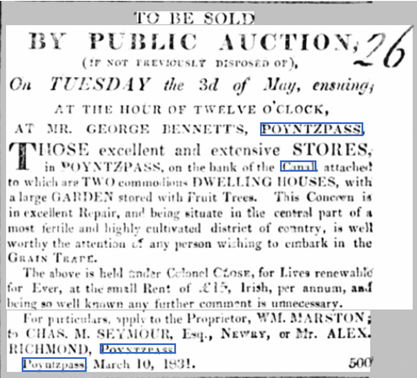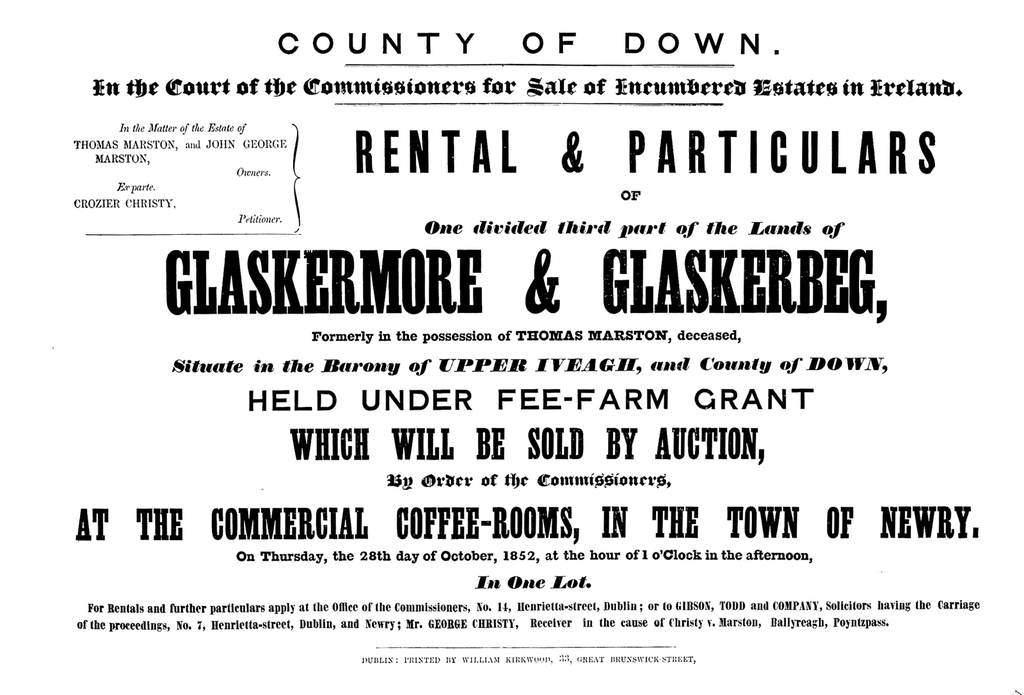I can find no record of whether Samuel Hanna initially used it for his own business or leased or rented it to someone else.

The next commercial transaction I can find is an advertisement for its sale at public auction on 3rd May 1831; it lists William Marston as the proprietor. He must have acquired it sometime during the preceding 30-35 years. Marston is mentioned in the Ballymore Tithe Applotment records for 1830 as being in Federnah; this probably relates to our house.
Fee Farm Grant, mentioned in the advert, is an ancient form of Irish tenure; the buyer would own the property and could dispose of it freely, but was still required to pay an annual rent to the seller, either for a set number of ‘lives’ or in perpetuity. It is similar to leasehold with an annual rent. “Lives renewable forever” means that the lease would never run out as long as the rent was paid on time.
George Bennett, on whose premises the auction was held, was a local businessman whose family owned several mills in the area.
We currently have no direct evidence of who purchased it at the auction. However, the most likely candidate is Maxwell Close, as he is the next person recorded as selling it.
William Marston appears to have died early in 1838; an advert calling for creditors of his estate to come forward appeared in April that year. According to the advert he lived in Lisnabrague. His grandson Isaac Marston (1840-1891) emigrated to the USA and eventually became Chief Justice of the state of Michigan.
Thomas William Marston’s son Thomas was one of the (hundreds of) signatories (“Noblemen, Gentlemen and Freeholders”) of a ‘loyal address’ to The Earl of Gosford, welcoming him to Gosford Castle, published in The Newry Commercial Telegraph dated 4th December 1838.
Liquidated

On 6th July 1850, an advert appeared in the Newry Telegraph, offering for sale, under the auspices of the Commissioners For Encumbered Estates, the estate of “Thomas Marston and another, Owners” with lands in Glaskermore and Glaskerbeg “for the purposes of discharging the encumbrances thereon”. The petitioner is Crozier Christy, and reference is made to “the cause of Christy vs. Marston”.
Crosier Christy was a prominent local farmer, a tenant of the Drumbanagher estate, and often appears in reports on local agricultural societies, including the Drumbanagher & Acton. So it looks as if the Marstons owed Christy money and that his petition to the commissioners tipped them into bankruptcy.
However, Thomas Marston had died in November 1840 so ……………………….
However, the sale did not take place until 28th October 1852. This time the “another” is listed as John George Marston, presumably William’s son and Thomas’ brother.
Interestingly, Thomas Marston “… labourer, previously of Poyntzpass, Co Armagh” is the subject of an insolvency petition on 22nd October 1855 in Dundalk.